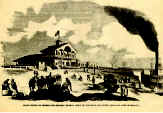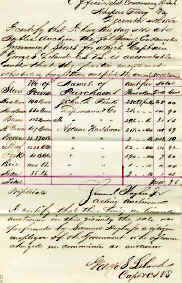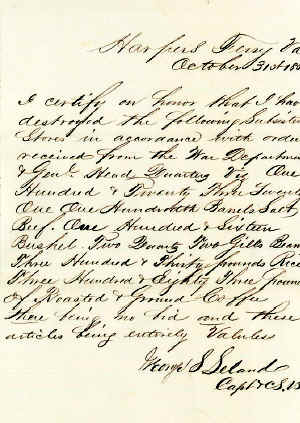George S. Leland and Civil War Logistics
By Matthew E. Stanley
Filson Intern
About |
 The word “logistics” derives from the Greek adjective logistikos,
meaning “skilled in calculating.” In that sense, its definition is appropriate
in describing how the Union Army utilized its logistical systems
to prevail in the American Civil War. In short, military logistics is
the discipline of maintaining large military forces in the field. This
practice often encompasses the acquisition of stores and their distribution,
as well as the maneuvering and coordinating of large armies
along bases of supply. When executed properly, as exemplified by
federal forces under Quartermaster Gen. Montgomery C. Meigs,
military logistics can be a deciding factor in an operation, campaign
or war.
The word “logistics” derives from the Greek adjective logistikos,
meaning “skilled in calculating.” In that sense, its definition is appropriate
in describing how the Union Army utilized its logistical systems
to prevail in the American Civil War. In short, military logistics is
the discipline of maintaining large military forces in the field. This
practice often encompasses the acquisition of stores and their distribution,
as well as the maneuvering and coordinating of large armies
along bases of supply. When executed properly, as exemplified by
federal forces under Quartermaster Gen. Montgomery C. Meigs,
military logistics can be a deciding factor in an operation, campaign
or war.
Capt. George S. Leland of the Office of Commissary Subsistence
in the Department of West Virginia, headquartered at Harper’s Ferry,
VA., and operating along the Baltimore and Ohio Railroad supply
artery, was but a “link in the chain” of broad Union logistical systems.
Nevertheless, his papers provide a detailed insight into the daily activities
of a Civil War quartermaster and the typical supply situation
of a Union field army. The Filson’s Leland collection, which spans
from 1862 to 1864, comprises of store estimates, invoices, lists of
provisions, and complaints from soldiers and local civilians. Leland
composed public letters, food orders, tallied railroad cargo, and
telegrams requesting rations and supplies. His offices also stocked
hospitals, transferred goods and evaluated troop numbers. From
Leland’s Papers, researchers can likewise determine the daily eating
habits of the men within his department. The evidence suggests that Union soldiers in
West Virginia consumed
salt bacon,
hard bread and Rio
coffee with expected
regularity. They also
used amenities such as soap, whisky and adamantine candles on a
daily basis.
invoices, lists of
provisions, and complaints from soldiers and local civilians. Leland
composed public letters, food orders, tallied railroad cargo, and
telegrams requesting rations and supplies. His offices also stocked
hospitals, transferred goods and evaluated troop numbers. From
Leland’s Papers, researchers can likewise determine the daily eating
habits of the men within his department. The evidence suggests that Union soldiers in
West Virginia consumed
salt bacon,
hard bread and Rio
coffee with expected
regularity. They also
used amenities such as soap, whisky and adamantine candles on a
daily basis.
Leland’s duties were wide-ranging. The captain acquired stores and equipage, upheld an inventory of detailed ration lists, addressed captured property and calculated how much subsistence a body of troops consumed over a period of time. Payment issued for services rendered by federal employees, including bricklayers, slaughterhouse workers and government bakers, was disbursed through Leland’s offices. Leland also received formal complaints regarding substandard rations. “There has been much complaint from Wheaton’s Brigade,” one officer informed. “The quality of the bread issued to them is inferior and badly baked. Put an end to this grumbling,” he warned. Another officer protested, “One Third of the hard bread issued to my command is unsound and totally unfit to be eaten.” Conversely, in Nov. 1863 under Special Orders No. 18, the department ordered Leland to “take charge of the [captured] Hershman, an alleged blockade runner.” In an unrelated duty, Leland was instructed to discharge deserter employees who had absconded from the government bake house in Annapolis, MD. From blockade runners to runaway cooks, Leland’s Papers underscore the variety of his responsibilities in the field.
Leland also received food requests from impoverished civilians.
“Unless you offer me something, me and my children will suffer
. . . I see no possible way of getting along without your help,”
implored one distressed citizen. In other cases, Leland’s offices
provided compensation to civilians for military destruction. Under
Special Orders No. 133 in July 1864, Leland was “authorized
to issue rations [to families] in destitute conditions . . . or whose homes have been destroyed for military
purposes.” In some of the more fascinating
correspondence, Leland was responsible for
determining the fate of spoiled goods. His
offices pawned off “unsound stores” such as
“maggoty bacon, honey-combed by vermin,”
“musty beans” and “decayed salt beef ” to unsuspecting
local buyers. Though the practice
of peddling “goods unfit for use” was not
exclusive to his department, it is surprising
that Leland kept a catalog of such ominous
transactions. “I have sold at public auction
the following condemned government
stores,” he notified his superiors. Whatever
the outcome of such matters, the number
of sales to and requests from citizens speaks
to the multiplicity of Leland’s tasks as quartermaster.
my children will suffer
. . . I see no possible way of getting along without your help,”
implored one distressed citizen. In other cases, Leland’s offices
provided compensation to civilians for military destruction. Under
Special Orders No. 133 in July 1864, Leland was “authorized
to issue rations [to families] in destitute conditions . . . or whose homes have been destroyed for military
purposes.” In some of the more fascinating
correspondence, Leland was responsible for
determining the fate of spoiled goods. His
offices pawned off “unsound stores” such as
“maggoty bacon, honey-combed by vermin,”
“musty beans” and “decayed salt beef ” to unsuspecting
local buyers. Though the practice
of peddling “goods unfit for use” was not
exclusive to his department, it is surprising
that Leland kept a catalog of such ominous
transactions. “I have sold at public auction
the following condemned government
stores,” he notified his superiors. Whatever
the outcome of such matters, the number
of sales to and requests from citizens speaks
to the multiplicity of Leland’s tasks as quartermaster.
Historians are just beginning to appreciate the need for an understanding of the role of logistical preparations in modern military organization. The Filson’s George S. Leland Papers, which also includes a chart for converting the bulk amount of various types of subsistence into the corresponding number of troops, is sure to profit researchers working on Civil War army and supply studies. Although recent scholarship has contributed greatly to our understanding of how Civil War armies were maintained on the campaign trail, the need for studies of logistics remains.
![]()
The Filson Historical Society
1310 South Third Street - Louisville, KY 40208
Phone: (502) 635-5083 Fax: (502) 635-5086
Hours
The Ferguson Mansion and Office
Monday - Friday: 9 am. - 5 pm.
Saturday and Sunday closed
Library
Monday - Friday: 9 am. - 5 pm.
Saturday: 9 am. - 12 noon
